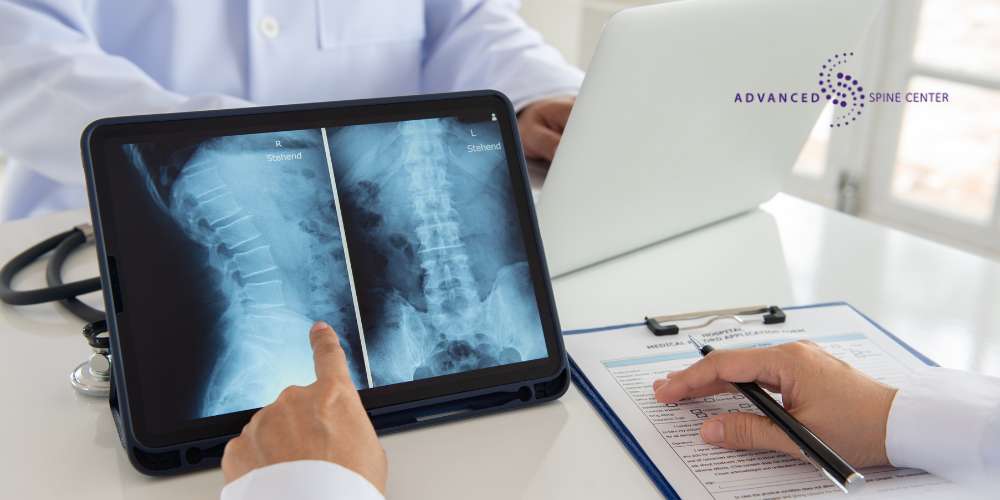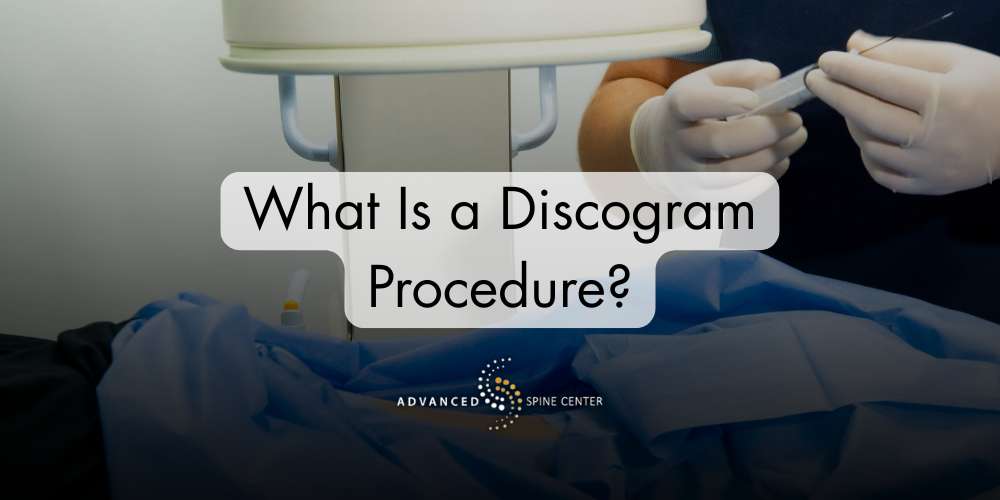A discogram procedure is a diagnostic test used to help diagnose chronic back pain and determine if a damaged spinal disc is the root cause. During the procedure, a special contrast dye is injected into the intervertebral discs in your spine to make the suspected disc visible. You will be positioned on an exam table, and the injection is performed under x-ray guidance to ensure accuracy.
A local anesthetic is used to numb the injection site, so you should only feel minimal discomfort. The dye makes the disc visible in the x-ray images, which helps your doctor identify any damage or issues contributing to your chronic back pain. Your blood pressure will also be monitored throughout the procedure to keep you comfortable and safe.
If you have been dealing with persistent back pain and want to explore the causes, a discogram might be the next step in your care.
To learn more about this procedure or schedule an appointment, contact the Advanced Spine Center in Plano, TX, at (972) 499-5457.
What Is a Discography or Discogram?
A discogram, or called discography, is a specialized diagnostic test used to determine whether a specific intervertebral disc is the source of your back pain. By injecting contrast dye into the suspected disc, doctors can see the structure of the disc on x-ray images.
If the disc is damaged or causing pain, the dye makes these issues visible, allowing for a more precise diagnosis. Discography is particularly helpful when other imaging tests, such as MRIs, don’t provide enough information about the cause of chronic back pain.
A local anesthetic is applied during the procedure to minimize discomfort, and x-ray guidance ensures an accurate injection. This procedure helps your healthcare provider create an effective treatment plan tailored to your condition.
Discogram vs MRI
When comparing a discogram to an MRI scan, it’s important to understand how these imaging tests differ. An MRI or CT scan is a non-invasive imaging test used to create detailed images of the spinal disks and surrounding structures. While MRIs and CT scans are great for detecting structural issues, they may not always identify the specific disc causing chronic back pain. This is where a discogram, or discography, can help.
A discogram is an invasive test performed on an outpatient basis, which involves injecting dye into the suspected disc under x-ray guidance to see if it replicates your pain. This helps doctors determine if the disc is responsible for the pain. Unlike other tests like MRI scans or x-rays, a discogram directly targets spinal disks to see if they are the cause of your discomfort.
The procedure involves local anesthesia, and your heart rate and blood pressure are monitored throughout to keep you comfortable. Discograms are particularly helpful when conservative treatments, like physical therapy, have not provided relief and more precise information is needed to proceed with treatment options.
What Conditions Can a Discogram Diagnose?

A discogram is used to accurately diagnose certain conditions that lead to chronic back pain, particularly when other imaging tests like a CT or MRI scan do not reveal the cause. This procedure can help diagnose conditions involving damage to the intervertebral discs, such as disc degeneration or tears in the disc.
During the test, if you feel pain when the dye is injected, it may indicate that the specific disc is the source of your lower back pain. By pinpointing the problematic disc, a discogram helps doctors determine the most effective treatment plan to alleviate pain and improve your quality of life.
Chronic Back Pain Symptoms
Chronic back pain symptoms can vary widely, but they often include persistent pain in the lower back that may radiate to other areas.
The symptoms can be similar to those of other spinal conditions involving the spinal column or spinal disks, making it challenging to pinpoint the exact cause. Individuals with chronic back pain may experience pain that worsens with movement, prolonged sitting, or standing.
Since back pain can stem from multiple issues, such as problems with the spinal disks, accurate diagnosis is essential. A discogram can help identify the specific disc that is causing the pain, especially when other imaging tests, like a CT scan or MRI scans, have not provided a clear answer.
Degenerative Discs
Degenerative discs commonly cause chronic back pain, especially as people age. Over time, the intervertebral discs in the spinal column can lose their flexibility, hydration, and cushioning ability, leading to degenerative disc disease.
This condition can cause the spinal disks to wear down, resulting in pain, inflammation, and reduced mobility. Symptoms of degenerative disc disease may include persistent back pain that worsens with certain activities, such as bending, lifting, or prolonged sitting.
A discogram can be a useful diagnostic tool for identifying which specific disc is affected by degeneration and whether it is contributing to the patient’s back pain.
Types of Discogram Procedures
Several types of discogram procedures target different regions of the spine. A cervical spine discogram evaluates discs in the neck area, while a thoracic discogram targets discs in the mid-back. A lumbar discogram focuses on the lower back, which is a common area for back pain. Each type of discogram helps accurately diagnose pain originating from specific spinal disks, enabling targeted treatment for relief.
Cervical Spine Discogram
A cervical discogram is a diagnostic procedure used to determine if the discs in the neck region are the source of a patient’s pain. This type of discogram involves injecting contrast dye into the cervical discs while using x-ray guidance. The dye helps to highlight any abnormalities in the disc, allowing doctors to pinpoint the cause of neck pain or radiating symptoms in the shoulders or arms.
Thoracic Spine Discogram
A thoracic spine discogram is performed to assess the discs in the mid-back area, known as the thoracic region. During this procedure, contrast dye is injected into the thoracic discs under x-ray guidance to help identify if any of these discs are contributing to persistent pain. Thoracic spine discograms are less common than cervical or lumbar discograms, but they can be helpful in cases where other imaging tests have not clearly indicated the source of mid-back discomfort.
Lumbar Spine Discogram
This type of discogram is a diagnostic test used to determine if the discs in the lower back are the cause of chronic pain. A lumbar discogram is particularly helpful for individuals who have persistent lower back pain that has not been clearly diagnosed through other imaging tests like MRIs or CT scans. This type of discogram can provide crucial information to help guide treatment decisions, such as surgery or other interventions to relieve back pain.
Is a Discogram Necessary?
A discogram is often considered necessary when other test results, such as x-rays or CT scanning, have not provided enough information to diagnose the source of chronic back pain accurately. It helps doctors determine if a specific disc is responsible for the pain, especially when conservative treatments have been unsuccessful.
How Long Does a Discogram Take?
The discogram procedure typically takes about 30 to 60 minutes to complete. This includes preparation time, the actual injection of the contrast dye, and imaging. After the procedure, patients are usually monitored for a short period before being allowed to leave, as it is performed on an outpatient basis.
The Discogram Procedure Explained

The discogram procedure involves injecting contrast material into the spinal discs to determine if they are the source of pain. Before the procedure, patients may be asked to stop taking aspirin or other blood-thinning medications to reduce the risk of blood clots.
During the procedure, the doctor inserts a needle through the skin into the disc, using x-ray guidance to ensure accuracy. A contrast agent is then injected into the disc to help identify any abnormalities, and x-rays are taken to capture detailed images. Your oxygen level, heart rate, and blood pressure are monitored throughout the procedure to ensure patient safety.
The goal of the discogram is to replicate pain similar to what the patient experiences, helping to pinpoint the specific disc causing the discomfort and assess how well the discogram works and complements other imaging tests like CT scans.
How Painful Is a Discogram?
A discogram can be painful, as its purpose is to reproduce pain similar to what you experience in your daily life. During the procedure, the injection of the contrast dye into the disc may cause discomfort or pain, which helps to identify the problematic disc.
The discomfort may last for several hours after the procedure, and medications can be provided to help manage this pain. It is also possible to experience an allergic reaction to the contrast material, though this is rare. Your doctor will closely monitor you during the procedure to ensure your safety.
Discogram Side Effects
Like any medical procedure, a discogram carries some risks of side effects. There is a slight risk of an allergic reaction to the contrast material used during the procedure. Patients may also experience discomfort or pain at the injection site where the needle is inserted.
In some cases, adverse reactions may occur, including inflammation or infection. The contrast agent can cause temporary symptoms such as nausea or stomach discomfort.
Although complications are rare, it is important to discuss any concerns with your healthcare provider before the procedure to ensure you are fully informed of potential side effects.
Discogram Recovery Time
Recovery time after a discogram is typically short, with most patients able to resume normal activities within a day or two. To prevent infection, it is important to keep the injection site clean and follow your doctor’s instructions carefully.
Applying an ice pack to the injection area can help reduce swelling and discomfort, and medications may be provided to manage any lingering pain. Your doctor will give you specific guidelines for post-procedure care to ensure a smooth recovery.
Contact the Advanced Spine Center for Prompt Diagnosis of Spinal Conditions in Plano, TX
If you are experiencing chronic back pain and need a prompt and accurate diagnosis of your spinal condition, the Advanced Spine Center in Plano, TX, can help. Our experienced team is committed to providing you with the highest quality care and effective treatment options.
Contact the Advanced Spine Center today at (972) 499-5457 to schedule your consultation and take the next step towards finding relief from your back pain.










